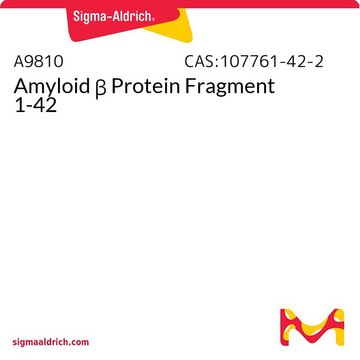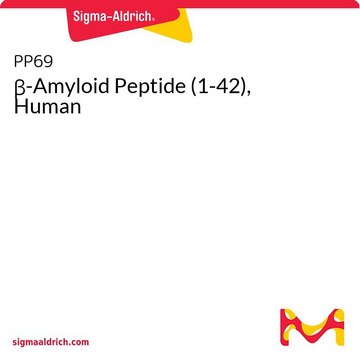About This Item
Wzór empiryczny (zapis Hilla):
C47H83N13O15S1
Masa cząsteczkowa:
1102.31
Kod UNSPSC:
12352202
NACRES:
NA.32
Polecane produkty
Amino Acid Sequence
Ac-Gly-Ser-Asn-Lys-Gly-Ala-Ile-Ile-Gly-Leu-Met
Opis ogólny
Amyloid-β (Aβ) peptides are a major component of the senile plaques characteristic of the Alzheimer brain. It is a type- I transmembrane protein. The amyloid β precursor protein is cleaved to amyloid peptides 36-43 amino acids in length. Aβ (25-35) represents the region that aggregates during plaque formation and is a functional domain implicated in both neurotrophic and neurotoxic effects. The gene encoding amyloid-β is localized on human chromosome 21. Acetylation may improve stability in in vitro and in vivo assays.
Zastosowanie
Acetyl-Amyloid β 25-35 has been used to prepare rat models with Alzheimer′s disease.
Ta strona może zawierać tekst przetłumaczony maszynowo.
Kod klasy składowania
11 - Combustible Solids
Klasa zagrożenia wodnego (WGK)
WGK 3
Temperatura zapłonu (°F)
Not applicable
Temperatura zapłonu (°C)
Not applicable
Wybierz jedną z najnowszych wersji:
Certyfikaty analizy (CoA)
Lot/Batch Number
Nie widzisz odpowiedniej wersji?
Jeśli potrzebujesz konkretnej wersji, możesz wyszukać konkretny certyfikat według numeru partii lub serii.
Masz już ten produkt?
Dokumenty związane z niedawno zakupionymi produktami zostały zamieszczone w Bibliotece dokumentów.
Monomeric Amyloid Beta Peptide in Hexafluoroisopropanol Detected by Small Angle Neutron Scattering.
Zhang-Haagen B
PLoS ONE, 11(2), e0150267-e0150267 (2016)
Conformational Dynamics of Specific A? Oligomers Govern Their Ability To Replicate and Induce Neuronal Apoptosis.
Dean DN
Biochemistry, 55(15), 2238-2250 (2016)
Effect of yizhitongxuan decoction on learning and memory ability, Gaq/11 expression and Na(+)-K(+)-ATP enzyme activity in rat models of Alzheimer's disease.
Teng J
Journal of Traditional Chinese Medicine = Chung i Tsa Chih Ying Wen Pan / Sponsored by All-China Association of Traditional Chinese Medicine, Academy of Traditional Chinese Medicine, 34(4), 470-476 (2014)
Yili Wu et al.
Scientific reports, 6, 22460-22460 (2016-03-05)
Down syndrome (DS), caused by trisomy of chromosome 21, is one of the most common genetic disorders. Patients with DS display growth retardation and inevitably develop characteristic Alzheimer's disease (AD) neuropathology, including neurofibrillary tangles and neuritic plaques. The expression of
Nasz zespół naukowców ma doświadczenie we wszystkich obszarach badań, w tym w naukach przyrodniczych, materiałoznawstwie, syntezie chemicznej, chromatografii, analityce i wielu innych dziedzinach.
Skontaktuj się z zespołem ds. pomocy technicznej

![[Ala28]-Amyloid β 25-35 ≥95% (HPLC)](/deepweb/assets/sigmaaldrich/product/images/306/938/dd9f7c72-cfca-4ea3-8e10-a7a2a7994639/640/dd9f7c72-cfca-4ea3-8e10-a7a2a7994639.jpg)

![[Gly35]-Amyloid β 25-35 ≥95% (HPLC)](/deepweb/assets/sigmaaldrich/product/images/154/487/d30c2077-f807-4989-855d-92ec012c4452/640/d30c2077-f807-4989-855d-92ec012c4452.jpg)




